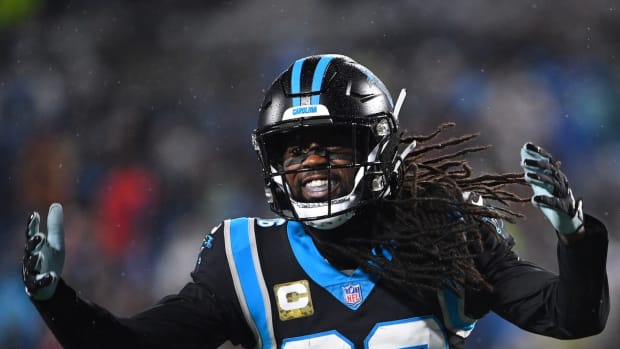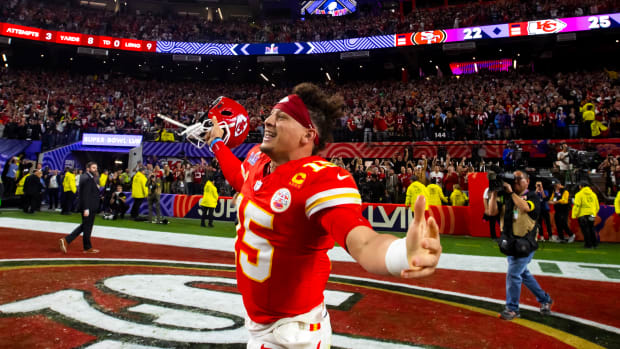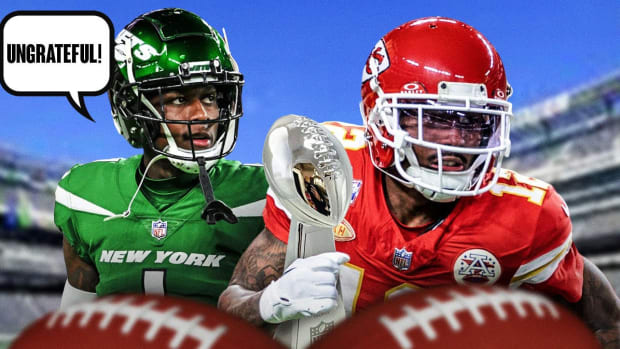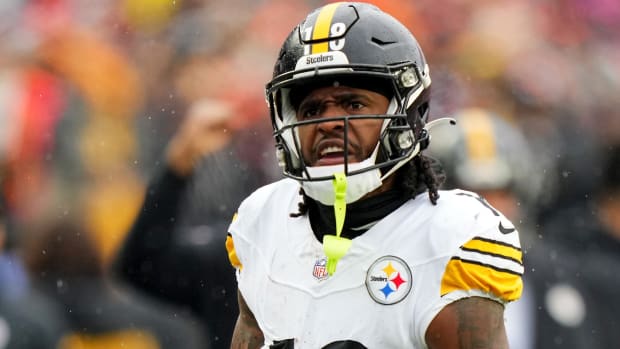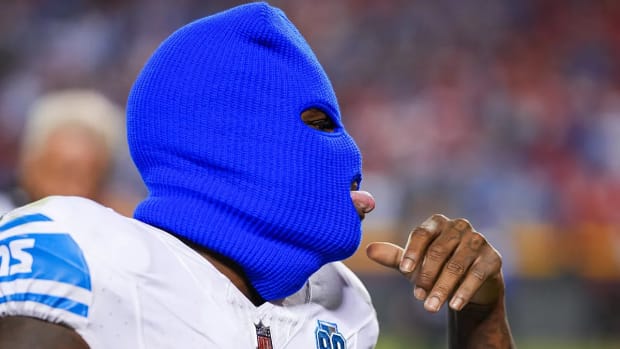For the Eagles to Beat the Patriots in Super Bowl 52, They Must First Not Beat Themselves
MINNEAPOLIS — We can break down whether the progress made by Nick Foles this month has been real. We can dissect how Philadelphia’s fierce front four matches up with New England’s offensive line. We can go through the advantage Tom Brady gives the Patriots, and wonder how the Eagles will combat Rob Gronkowski.
But before any of that matters, for the Eagles to win Super Bowl LII on Sunday, they need to make sure to avoid the one thing that’s taken out challenger after challenger to the Patriots’ throne. They have to avoid screwing it up. Take it from someone who’s seen it from the other side.
“(The Patriots) don’t always bring in the most talented athletes, but they bring in an athlete that fits their system, an athlete that’s tough, a smart athlete that’s not gonna make too many dumb decisions,” Chargers coach Anthony Lynn said over the phone Tuesday. “If you can match that for four quarters, your chances are good. I can’t tell with how many times I’ve played against this team, you lose the game because you beat yourself. They don’t necessarily beat you, you beat yourself.
“And they will allow you to do that. Coach (Bill) Belichick has always been game-plan specific, but there have been times against us where he’d play certain coverages that would allow us to move the ball on the ground and through the air, but it feels like he knows that you get too many opportunities, you’re gonna screw it up. They count on that. They actually count on you screwing it up.”
In the divisional round against New England, the Titans were on the wrong side of a couple questionable calls by the officials, and crumbled. In the AFC title game, the once-aggressive Jaguars took knees at the end of the first half, then folded up the tent in the fourth quarter by bleeding clock on offense and playing back on defense, and the Patriots pounced.
These aren’t mistakes. And based on what Eagles coach Doug Pederson said in the bye week ahead of Super Bowl LII, Philly’s antennae is up for what’s taken so many teams to their knees against New England.
In this week’s Game Plan, we’re going to break down both sides of the blockbuster deal that sent Alex Smith off to Washington; we’ll look at little things Sean McVay is doing in Los Angeles to create the right kind of environment for his Rams; we’ll take a quick look at the next rising star in Belichick’s coaching tree; and we’re going to examine what keeps Tom Brady going, even with a great life waiting after football.
But we’ll start right here with the big game. I went to the playbook of late, great Boston Globe columnist Will McDonough, whose work was a big reason I got into this business. Before Super Bowls, McDonough used to tap a couple coaches for insight into the matchup. So we’ll use Lynn and Carolina’s Ron Rivera, since the Chargers and Panthers played both Super Bowl teams this year.
(For the record, Lynn’s Chargers lost to the Eagles, 26-24, on Oct. 1, and to the Patriots, 21-13, on Oct. 29. Rivera’s Panthers beat the Patriots, 33-30, on Oct. 1, and lost to the Eagles, 28-23, on Oct. 12.)
Here are the keys, as the coaches see them, to the matchup…
• Benching Brady. The Eagles led the NFL in time of possession in the regular season, running 97 more plays than their opponents. And in the playoffs, they’ve averaged more than 33 minutes of possession per game. Good thing they’ve proven they can do it, too, since the best way to beat Brady is to keep him on the sideline.
“Defensively, we had to be really good on third down, we had to win third down,” said Rivera, whose Panthers won in Foxboro in Week 4. “That was a huge emphasis going into the game, because you didn’t want to give Tom Brady extra snaps. We had to limit his chances. And we had to run the ball successfully, and if not that, our short passing game had to be there so we could complete passes to keep the clock going.
“I thought Jacksonville was doing a great job of that. But in the end, when they had to convert in the fourth quarter, they couldn’t, and gave Brady back the ball. We know what Tom is, and especially in the fourth quarter. The dude is phenomenal.”
• Finding Fletcher.Lynn coached in the AFC East for eight seasons, and so he knows the way to beat Brady is to go right through him. And the way to him, generally, is a direct shot through the middle of the defense, which makes Eagles defensive tackle Fletcher Cox perhaps the most important non-quarterback in this game.
“He’s tall and he has such patience and poise,” Lynn said of Brady. “When you have great edge rushers, a lot of times quarterbacks will panic because they feel that pressure. Brady just steps up in the pocket and delivers the ball. It doesn’t affect him whatsoever. Trust me, I’ve seen it up close and personal too many times. Pressure that’s in his face, now you gotta get out of the pocket. That’s out of his comfort zone.
“And in all my years playing against Tom Brady, that’s what affected him most, the pressure up the middle. So they’re gonna have to decide. Do you leave the tackles one-on-one with the edge rushers and send help to Cox? You can do that with the center or whatever uncovered guard you have, you can slide to Cox and put two guys on him. But you’re going to single up some guys on the edge.”
• Breaking tendencies.This is a New England specialty, and where Philly’s coaches have to go to work. Their defense isn’t overly complex, but varying matchups up front is a way they throw in wrinkles. Rivera suggested using linebackers in the pass rush, to keep the New England backs in blocking. Likewise, the Eagle offense has to keep the Patriots off balance. And all this usually means even more when the chips are down, and teams tend to revert to what they do best.
“It gets very hard,” Rivera said. “Believe me, Coach Belichick prepares. And knows like the back of his hand what you’re going to do in the fourth quarter. He knows what to anticipate as far what you’re going to call offensively, defensively, on special teams. And you have to do a really good job of self-scouting—it’s just them, you have to scout yourself, because he’s gonna know you.
“Then when you feel good about you, now you’ve gotta get ready for them. There’s a lot of work in getting ready for them. There are no slam dunks against Coach.”
For Philadelphia and New England, the Super Bowl Could Come Down to Versatile Safeties
• Situational play. We already mentioned third down. The red zone is another area where the story for this one will be written. The Patriots’ excellence there explains how a team that ranks 29th in total defense could possibility finish fifth in scoring defense. And so it’ll be on Foles and Co. to be judicious inside the 20.
“It’s hard to beat that team if you’re kicking field goals, I’ll tell you that, because they have a quarterback that’s going to score touchdowns,” said Lynn. “They’re very sound in their techniques and with their philosophy. They do a good job of mixing coverages down there and keeping you off balance. They don’t do a whole lot, but they do enough to where their guys can still play fast, physical and react.
“They’re going to defend the end zone. And a lot of times, quarterbacks don’t have the patience to sit in the pocket and take what a team gives you. They’ll force the ball into the end zone. That’s what they want you to do. They’ll defend the line and force you to kick field goals.”
• Foles on schedule. The hardest thing about playing the Eagles, Lynn remembers, wasn’t all the things they could plan. It was what they couldn’t plan. And with Carson Wentz out, how the Eagles operate in those spots will be key.
“At the time, the quarterback was making so many plays off schedule,” Lynn said. “His ability to move around and extend plays, and his receivers’ ability to stay in sync with him, we did a stat in the fourth week of the season, and it was unbelievable how many touchdowns and first downs they’d made off of that. They’re gonna miss that a little bit, that was part of the formula.”
Conversely, the rap on Foles has always been that he couldn’t operate when he was getting knocked around and off schedule. That’s changed in these playoffs, but you can bet the Patriots will test to see how real his progress has been.
Before He Became the Eagles' Backup Plan, Nick Foles Was Working on His Backup Plan
And then, there’s this: One team comes into this game with five Lombardis in the cabinet, and with a quarterback and coach here for the eighth time. This, simply, is where they do their best work. The last four times they’ve faced double-digit deficits in the playoffs, they’ve won. Read that sentence back one more time. It is absolutely staggering.
Faced with it, Atlanta came undone in Super Bowl LI, and the Jaguars wilted two Sundays ago. That’s why Rivera really liked what Pederson did publicly last week, in addressing the Patriots’ “mystique” head on, because when the game goes to the fourth quarter, the mind can play tricks on teams faced with all that.
“You gotta make sure it’s not like, ‘Here we go again’,” said Rivera. “You have to get that out of everybody’s mind. And I thought Doug did a really good thing. ‘Let’s get past the New England mystique, OK? Let’s get past it!’ Seriously. I think Bill Belichick thrives on that stuff. If you want to emulate the gold standard, they’re the gold standard, he’s the gold standard, Tom Brady’s the gold standard.
“And so I think Doug addressing it last week was important, so now if some things comes up, it’s, ‘Guys, we already talked about it.’”
That is when teams tend to step in it. At the very least, the Eagles seem ready for that.
FIRST AND 10
1. We’ll further discuss the Alex Smith trade in the next section, but my god was this avoidable for Washington. A four-year, $94 million deal would’ve been more than enough for Kirk Cousins two years ago. It also wouldn’t have cost much more over two years than the two franchise tags did, and the team would likely be out of the guaranteed portion of the deal by now, giving it flexibility to move on if it so chose. Just a massive blunder by the Redskins.
2. Speaking of guarantees, how about we wait to see the full guarantees on Smith’s deal before jumping to conclusions on how long he’ll be a Redskin. If there’s an escape hatch in the deal after, say, 2019, then it’d be tough to rule out the idea that Washington could draft Smith’s replacement in April.
3. When we’re talking about the interesting quarterback market ahead, it’s impossible not to quickly turn to the Vikings’ predicament and wonder where they’ll go with pending free agents Teddy Bridgewater, Sam Bradford and Case Keenum. Two things worth pointing out there. Bridgewater still has support in the building. And the Vikings are looking at having more than $50 million in cap room, putting them in the top quarter of the NFL in 2018 spending power.
4. We’ll take a quick look back at the week in Mobile here, and the quarterbacks are a good place to start. With the exception of Nebraska’s Tanner Lee, who was up and down, every quarterback helped himself in the eyes of scouts. Oklahoma’s Baker Mayfield and Wyoming’s Josh Allen each had good weeks, as did Washington State’s Luke Falk, who had a bit of a rough Day 1.
5. Because of the spread offense he comes from, Oklahoma State receiver James Washington needed a good week, and he had one, dominating one-on-ones and showing off the big-play ability and speed he did in Stillwater. Kansas State junior Byron Pringle was another receiver who turned heads.
6. And one last name to get to here: Arizona State running back Kalen Ballage. A big back at 6-foot-2 and 222 pounds, Ballage looked fast for his size and that should help him make his way in a very deep group at running back.
7. NFL commissioner Roger Goodell turned heads when he said Charlotte is “a market we would like to stay in” at his annual state of the league presser on Wednesday. I wouldn’t get too worked up, if I lived in the Carolinas. Jerry Richardson’s the one selling the team, and he cares deeply about his legacy there, knows it’s been tarnished, and almost certainly would love to avoid any further damage to his good name in his home region.
8. I’ll be interested to see how Drew Brees handles his situation over the next six weeks. He’s said all the right things, and went on “Ellen” Wednesday and made it clear again: “I’m a Saint for life.” It’s worth paying attention to that, of course, but Brees has always been a master at maximizing his leverage, and has a belief that one player getting top dollar helps all players. And the way to maximize your leverage and get top dollar is, without question, to get to the market.
9. To close the book on the Texans’ restructure, it’s worth saying the relationship between a coach and quarterback is as important as it gets. Had Bill O’Brien and Deshaun Watson not clicked the way they have over the past nine months, there’s a good chance the outcome in Houston would’ve been different.
10. And speaking of closing books, I’d say the five-year deal FOX just did to secure Thursday Night Football closes one on the idea of ridding the NFL of its second weeknight property. Guess what? The league was never going to walk away from the revenue TNF has basically generated out of thin air.
FOUR DOWNS
1. What the Alex Smith trade means for the Chiefs. There are a couple pieces of important fallout in the wake of the trade of Alex Smith for Kansas City. And the first is 22-year-old Patrick Mahomes becoming the team’s starting quarterback. Here’s what those inside the building will tell you: He earned it. The Chiefs coaches gave Mahomes the start at the end of the season for that reason. Against Denver in Week 17, he showed them what they wanted to see, protecting the ball, and getting it out on time with a calculated aggression.
“The 40-second process in between is so much smoother,” is how one Chiefs coach explained his progress to me at the time. “Hearing the play, calling it, motions, shifts, Mike (linebacker) IDs, coverage recognition, all of that is much easier for him. Throwing the football has always been the easy part, the fun part for him. He keeps growing with the protections and understanding the why’s—it’s a puzzle for him. And he’s got a lot of pieces left, but he’s way ahead of schedule.”
Before the year, the staff wanted to get Mahomes to the point where, when the huddle broke, he’d be looking at the defense, because he was confident in his knowledge of the offense and the play call. They got him there, and now we’ll all get to see his talent. And based on the circus throws he’s capable of making, that should be fun to watch.
There’s another element to this trade, too, that shouldn’t be overlooked, beyond just the third-round pick (which in essence moved a comp pick the Chiefs would’ve gotten in 2020 up two years). If he can stay healthy, Kendall Fuller will be a very real player for the Chiefs. The frustration of the team’s long search for a corner to play opposite Marcus Peters was illustrated perfectly in the fall by the signing of Darrelle Revis off the street. Fuller should put an end to that frustration, and his presence should allow defensive coordinator Bob Sutton, an aggressive play-caller at heart, to be more creative.
Washington Swaps Out Kirk Cousins for Alex Smith, But Did The Team Improve?
2. What it means for Kirk Cousins. Two years ago, the Redskins told Cousins, on a $19.95 million franchise tag, that they wanted to see more before consummating a big long-term deal. Cousins played great. A year later, on a $23.94 million tag, and with coordinator Sean McVay, GM Scot McCloughan, and receivers Pierre Garcon and DeSean Jackson gone and the franchise mired in some level of chaos, Cousins returned the favor. He told the team he liked how the spring had gone, and that he appreciated the team wanting to open talks on a mega deal, but he wanted to see how the season played out before going all-in on his future in Washington.
So in the end, with Smith coming in and Cousins going out, timing never matched up where the team and player wanted each other bad enough to stop dating and get married. This should inform you, to some degree, on what Cousins will be looking for in the coming months. Remember, he was a fourth-round pick, and never quite engendered the kind of love that Dan Snyder and upper-level management had for the guy, Robert Griffin III, that he wound up beating out. My sense is getting that kind of love somewhere else will appeal to him, as much as money and winning.
Cousins, I believe, will be looking for a team that is eager to install him as the face of the franchise with the intention of building around him. And so I’d think he’d do his homework to try and avoid a situation like Sam Bradford had in Philly in 2016 or Mike Glennon had this year in Chicago, where a rookie replacement was drafted months after a veteran’s contract was signed. That doesn’t mean a team has to say to Cousins that they won’t stock the position with developmental players or veteran depth. But for teams like the Jets or Broncos or Browns, it may mean telling him they don’t plan to take one with their Top 10 pick.
3. The new Walsh tree? This week, Rams coach Sean McVay lost another assistant, and that’s significant. But maybe not for the reasons you probably figure. A couple weeks after losing quarterbacks coach Greg Olsen when the Raiders tabbed him to be their new offensive coordinator, Rams OC Matt LaFleur bolted L.A. to become Mike Vrabel’s coordinator and play-caller in Tennessee.
There are two things to point out here. First, there’s the fact that McVay could’ve blocked both guys. In many cases, young coaches will do just that. But he knew that Olsen had a relationship with Jon Gruden, and that going back to the Bay Area was best for his family; and he knew that LaFleur wanted badly to take the next step and become a play-caller himself. So he let both go when most young coaches, in the same circumstance, wouldn’t. Maybe there’ll be a short-term hit to losing LaFleur and Olsen, and certainly it’s a risk in shaking up Jared Goff’s surroundings. But McVay is creating the kind of environment in Los Angeles that people, both players and coaches, want to work in and this is a great example of that.
Second, it’s certainly worth noting that there are now three coaches from the 2013 Redskins offensive staff (McVay, LaFleur, Kyle Shanahan) that will be play-callers in 2018, and that doesn’t count a fourth (Jets coordinator Jeremy Bates) who’s from that coaching tree. On top of that, you’ve got the right-hand men of McVay and Shanahan—Rams pass-game coordinator Shane Waldron and Niners run-game specialist Mike McDaniel—who are trusted confidants of their bosses and gurus with potential to reach that level. When you add that up, you see the potential for this group, with roots in the Mike Shanahan version of the West Coast offense, as being the next offensive tree were everyone is looking to pluck a branch. I thought back to a conversation I had with McVay in September, where he explained his goals for the offense.
“The way we approach the quarterback, everything we do has the quarterback in mind first and foremost, because I think that’s the most difficult position,” he said. “You want to make it as easy as possible for those guys. The things that will accentuate with Jared vs. Kirk (Cousins), while there’s a similar approach, there are some different things that they each feel comfortable with that we might call, because ultimately it’s about them feeling good about, not me. I mean, I’ve got a handful of plays that I like but I don’t ever wanna run plays that our players aren’t comfortable going and executing. It’s an ongoing thing as I get to know him. Working with Kirk a little bit longer, you knew what he liked and we were able to grow in a system together. It’s been a great process so far.”
Four months later, we know the process worked for the Rams. And it’s natural that others want to buy into it. Good on McVay for letting it happen.
4. More of the next wave. This Super Bowl isn’t a bad place to look for future head coaches either, and it goes well beyond Colts coach-to-be Josh McDaniels and Lions coach-to-be Matt Patricia. The Eagles have three guys—oordinators Jim Schwartz and Frank Reich, and quarterbacks coach John DeFilippo—whose names were bandied about during this cycle, and could be again in early 2019. And a new one emerged this year in Patriots linebackers coach Brian Flores. That he interviewed for the Cardinals’ job was a personal breakthrough, but the writing has been on the wall for some time in Foxboro on him. Some in the building believe his future is as bright as anyone’s on Bill Belichick’s staff, and he’s been earmarked to succeed Belichick for a few years now.
When I asked Patricia about Flores on Monday, the report came back glowing: “Tremendous worker who’s tried to learn a lot about the game in its entirety. He’s worked on all different avenues—scouting, special teams, offense, defense, back end, front end—so he really has an unbelievable overall knowledge of the game, which is great. And then-position specific, it’s really mastering the techniques he’s teaching those guys, both in the back end in coverage and in the run game. I mean, tireless worker, guy that does a great job of educating himself and trying to improve and put his players in great position to make plays. … And Flo has great command, great presence.”
The Patriots linebackers had similar praise for him, with the defense’s signal caller, Kyle Van Noy, being one who made a big leap as a player under Flores’ watch. “Honestly, he let me play my game,” Van Noy told me. “He’s not trying to control everything. He let me be a football player. That’s what he does best. He lets you be a football player, but hones in on the skills and the attention to detail you need. You gotta love that as a football player—a coach that trusts you to do your job. He’s not easy, he’s still hard on you. But the trust he has in us to get the job done, I love that.”
Veteran David Harris echoed Patricia in saying it was Flores’ overall knowledge of the game, beyond just his position assignment, that sticks out, in addition to his command. All of this should tell you that the foundation for a future in front of an NFL meeting room is in place with Flores.
LESSON OF THE WEEK
I used to be like a lot of you. I used to think Tom Brady was just waiting to get his legacy in the perfect place, find the perfect ending, and then fade off into the sunset to live the perfect life with his supermodel wife and three children. And I don’t blame anyone for assuming that, because that’s what most people would probably do.
Our lesson for the week: Tom Brady is not like most people.
Obvious, right? Well, I mean it in a different way. I no longer, and haven’t for a few years, thought that Brady was motivated by creating some storyline for his life because I think he’s doing exactly what he wants to be doing.
And I don’t mean just playing on Sunday, either. Most guys who retire on their own accord, and there aren’t many of them, don’t quit because they stop liking Sunday. It’s usually because they fall out of love with Monday through Saturday, and an offseason of getting ready for the rigors of an NFL year.
Brady not only hasn’t fallen out of love with that, he exactly seems to enjoy that part of job, at 40 years old. That makes him, like I said, unlike most everyone else.
“My take on it is simply that he loves every part of the football process,” Brady’s dad, Tom Brady Sr., said over the phone Tuesday afternoon. “He loves hanging with the guys in the locker room, he loves offseason workouts, he loves the camaraderie, he loves the thrill. And so just because they play 19 Sundays a year doesn’t mean he has 19 high points. He has a high point every day doing what he does.
“He loves watching film, he loves dissecting it and analyzing it, he loves leadership, he loves all of this stuff, and all of it happens to coalesce into a football career.”
Brady now ranks ninth in the NFL in career starts. Health permitting, he’ll pass Peyton Manning next fall. He’s four full seasons of starts away from catching Brett Favre for the all-time record, and that’s not counting the record 27 playoff starts (11 more than any other quarterback) he’s made in his 18 seasons.
His dad will tell you that, as far as he knows, his son plans to get there. In fact, when I asked if he has any sense for when Brady Jr. will hang it up, he quickly answered, “Zero.”
“I remember talking to an old quarterback and he said, ‘I fell on the ball when I was 37, and I never wanted to play in this game again. I dove and the ball hit me and my ribs hurt so bad, I just wanted out,’” Brady Sr. said. “And he said, ‘I quit at 38.’ He just hasn’t gotten to that point. There’s still a joy in scrimmage. There’s still a joy in offseason workouts, and all of the necessary ingredients that go into the mix.”
Brady Jr. has said before that he wants to play until he’s 45, and that number isn’t arbitrary. It’s one that Drew Brees has used too, and one reason why is that it’s how long Tom House—the throwing mechanics coach to both—says quarterbacks can maintain a certain level of play, based on his study and his work with Nolan Ryan a couple decades ago.
House’s conclusion has been that athletes hit 45 and they physically can’t recover the same way, which affects their ability to prepare and bounce back from each competition. For many, that part is a non-factor, because they tire of the grind well before then.
That Brady hasn’t is both remarkable, and an explanation of how he’s pulling off what previously seemed borderline impossible.

































